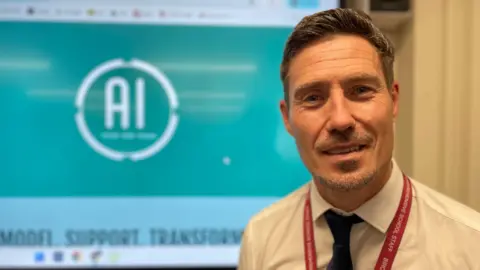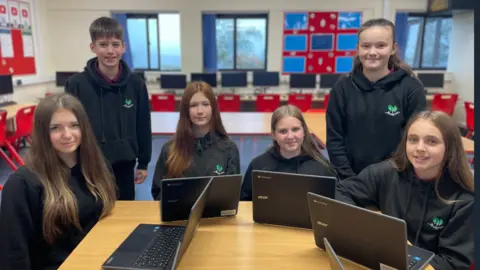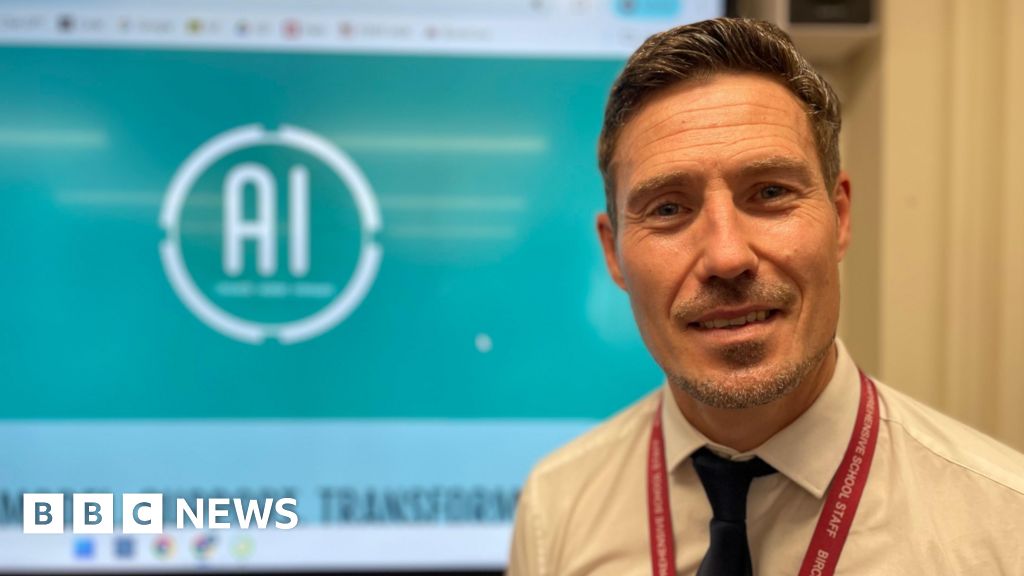Bethan LewisWales family and education correspondent
 BBC
BBC
Ryan Cresswell, a teacher at Birchgrove Comprehensive School in Swansea, says they are “very positive” about using AI while teaching pupils how to use it responsibly
AI can substantially cut teacher workloads and help pupils learn but schools need clearer guidance on how to use it “safely and ethically”, the education watchdog has said.
Estyn’s report on artificial intelligence says some teachers are using it to plan lessons and to draft letters to parents and pupil reports.
However, teachers also reported concerns that AI could negatively affect pupils’ skills while some were worried about plagiarism and inappropriate use of the technology.
The Welsh government said it was important to balance the effective use of AI with the safety and wellbeing of pupils and staff.
‘Promote curiosity’
At Birchgrove Comprehensive School in Swansea, they teach pupils how to use AI as part of ICT (Information and Communication Technology) lessons and staff across the school are encouraged to become more AI-literate, while it can be used by pupils to help them research a subject.
“If we see a pupil using it, we encourage them to use it but we encourage them to use it responsibly and that really does have a positive impact,” says Ryan Cresswell, the school’s digital and innovation lead.
“Our approach is to be very positive about it, because our feeling is, if the pupils are going to be using it, we’d rather teach them how to use it responsibly than just ignore it”.
He said there were “absolutely valid concerns” about pupils using it, is “as a crutch as opposed to a learning tool.
“The big concerns that we have from staff are obviously that they say ‘how do we know that they haven’t submitted this work using AI?’
“The simple answer to that is we know our pupils, we know the work that they’re capable of because we see them day in and day out”.
He said the aim was to use AI to “accelerate” learning and “promote curiosity”.

‘When you use it in the correct way it can help you’
The Estyn report found that secondary school pupils were using AI for tasks such as summarising revision notes and creating quiz questions tailored to exam content.
But it found that there were big variations in how much pupils used it.
Some were “more fearful, concerned about what use is permissible and worried that teachers will accuse them of cheating if they do use it”.
Thirteen-year-old pupils at Birchgrove Comprehensive said they used it for revision and to go over what they had learnt in a lesson.
“I think it’s useful. Teachers can find out if we’re cheating or not but when you use it in the correct way it can help you”, said Grace.
Maya said: “If I’m curious about something in the house I might ask AI and they will answer me.
“If I don’t get anything in class, I’ll search it up and ask it to break it down for me”, Emilia said.
“I double check it on lots of other websites to make sure it’s definitely the right answer.”
Overall Estyn found most schools they visited were “in the early stages of exploring the benefits of AI, with pockets of experimentation led by digitally confident and curious staff”.
But in most cases, “AI adoption was ad hoc and usage varied considerably between individuals, phases of learning and departments.”
It said many staff “were excited by the potential of AI but wary of its use” adding that they “generally expressed caution about AI’s potential issues, such as accuracy, bias, and safeguarding risks”.
The report said using AI to draft letters and reports had helped some schools by “substantially reducing administrative workloads” freeing up staff to focus more on pupils.
Teachers also told Estyn that AI could be effective for tailoring resources to individual pupils, particularly those with additional needs.
What is AI?
It can create new content – which can seem like it has been made by humansIt can do this by learning from vast quantities of data, such as online words and imagesGenAI or generative AI is artificial intelligence that can create new content such as text, images, videos, and music.
What are teachers using AI for?
Tailor learning for pupils with special needsLesson planning, report writing – so saving time and cutting workloadGenerating tasks or texts to meet the needs of all pupilsSimplify texts to make them more accessible to pupilsSummarise meeting notes, reports and planning docs
Andrew Owen, headteacher of Birchgrove Comprehensive said some pupils found it difficult to process information.
“They struggle with the amount of information that they’re asked to use in their education and I think an AI tool allowing pupils to summarise articles and to actually sift the information that’s really important can be a real asset to their learning”.
Mr Owen said he was initially wary of AI.
“I felt apprehensive. I didn’t have the skills to actually understand it fully.”
He said they had decided to “embrace it” to help with school administrative tasks as well as in teaching and learning.
“It has many risks if misused and I think from an educational perspective the use of AI has moved on very quickly and we owe to the pupils in Birchgrove to try and educate them about the acceptable use of AI”.
He said more guidance would be welcome, as everyone was struggling to catch up.
The Welsh government said it accepted Estyn’s recommendations including more training for staff and national guidance on implementing AI in education.
“It is essential to balance the effective use of gen AI, while prioritising the safety and well-being of our learners and workforce.”


